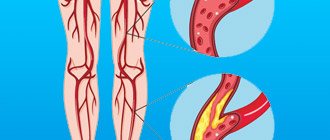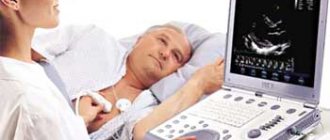Frequent manifestations of VSD (vegetative-vascular dysfunction) are vegetative crises and panic attacks. They usually occur suddenly, during sleep or when a person wakes up. The patient experiences symptoms that interfere with his quality of life. To relieve them, doctors at the Yusupov Hospital use modern medications and non-drug therapy methods. After emergency care is provided, the cause of the disease is determined and planned therapy is carried out.
Drugs and their doses are selected individually for each patient. Psychotherapists use psychotherapy techniques that help prevent panic attacks. Medical staff respects the physical and mental health problems of patients.
Vegetative crisis in patients suffering from VSD
Autonomic crises occur in 64% of patients with vegetative-vascular dysfunction. There are sympathetic-adrenal, vagoinsular (parasympathetic) and mixed crises. Sympathetic-adrenal crisis is manifested by the following symptoms:
- A feeling of anxiety, unaccountable fear;
- Severe headache, sensation of pulsation in the head;
- Unpleasant sensations or pain in the heart area;
- Increased blood pressure;
- Pupil dilation;
- Strong sensation of heartbeat, tachycardia, interruptions in heart function;
- Pale and dry skin;
- Chills with tremors (shaking hands), elevated body temperature.
The crisis ends suddenly and is accompanied by general weakness and copious urine output with low specific gravity. A vagoinsular (parasympathetic) crisis is characterized by weakness, nausea, and dizziness. Patients experience a decrease in blood pressure, a feeling of fading and interruptions in the functioning of the heart, and the pulse becomes rare. There is a breathing disorder, a feeling of lack of air.
Patients are worried about slight dizziness, a feeling of “falling through.” The skin becomes moist, red, and covered in sweat. The function of the digestive tract is impaired. After the crisis, severe asthenia is noted. A mixed crisis is manifested by symptoms of vagoinsular and sympathetic-adrenal crises.
Based on the severity of the course, they distinguish between mild, moderate and severe vegetative crisis. In a mild crisis, there is only one symptom. Autonomic disorders are expressed within 10-15 minutes. With moderate severity of a vegetative crisis, several symptoms are identified. The duration of autonomic disorders is from 15 to 20 minutes to one hour. After the crisis, asthenia is observed within 24-36 hours.
A severe polysymptomatic crisis is manifested by severe autonomic disorders, pathological sudden involuntary movements in the limbs, and convulsions lasting more than one hour. Asthenization continues for several days after the crisis.
Treatment of sympathoadrenal crisis includes drug and non-drug therapy. Patients are prescribed the following medications:
- Antidepressants (ludiomil, melipramine);
- Serotonin reuptake inhibitors (cipramil, paxil);
- Tranquilizers (antelepsin, zodak).
To relieve an attack, fast-acting drugs are prescribed - lorafen, relanium. Non-drug therapy includes following a daily routine, getting enough sleep, avoiding energy drinks, alcohol, and caffeinated drinks.
How and why a vegetative crisis occurs
Despite the fact that science has not yet fully elucidated the cause of such exacerbations, diagnostic studies have revealed that a vegetative crisis occurs due to the following factors:
— genetic predisposition; - hormonal imbalance; - taking potent medications; — disturbances of psycho-emotional balance and stress; - endocrine diseases.
A common reason for the appearance of the first symptoms of a vegetative crisis and the worsening of this condition is domestic violence, as well as social reasons.
Vegetovascular dystonia with panic attacks
A panic attack is an episodic manifestation of anxiety that begins suddenly for no apparent reason in patients suffering from VSD. The attacks last from a minute and can last an hour. Sometimes panic attacks occur periodically several times a week, or may not make themselves felt for a long time.
A panic attack during VSD is manifested by extremely pronounced anxiety (panic). It is accompanied by fear of death, self-control, loss of consciousness, fear of going crazy and pronounced vegetative symptoms:
- Increased sweating;
- Accelerated heartbeat;
- Chest pain;
- Nausea;
- Feeling hot or chilly;
- Dizziness;
- Discomfort in the abdomen;
- Trembling hands.
The symptoms of a panic attack can vary from person to person. The attack begins suddenly and lasts from several minutes to several hours. Panic attacks can be associated with a certain situation, environment, place, and arise spontaneously, regardless of external circumstances. The key difference between isolated panic attacks in VSD and panic disorder is the absence of the formation of fear of anticipation of a new panic attack and protective behavior - avoiding situations and places in which a panic attack has already occurred.
Classification
There is no single classification. Vegetative crisis is classified according to severity and symptoms, divided into types depending on changes in blood pressure and the cardiovascular system.
According to severity they are distinguished:
- lungs: last 10-15 minutes with pronounced vegetative changes and monosymptomatic manifestations in the absence of post-crisis asthenia.
- moderate severity: last from 15-20 minutes to 1 hour with polysymptomatic manifestations and severe post-crisis asthenia up to 24-36 hours.
- severe: polysymptomatic crises in combination with hyperkinesis, convulsions lasting more than 1 hour and asthenia lasting up to several days.
According to symptoms there are:
- sympathoadrenal
- vagoinsular
- mixed
Autonomic failure
Autonomic failure is a syndrome associated with impaired innervation of internal organs, blood vessels and endo- and exocrine glands.
In most cases, it is a progressive autonomic failure. In turn, MNV includes primary violations:
- idiopathic orthostatic hypotension;
- some hereditary and acquired diseases of the nervous system (multiple system atrophy, hereditary sensory-vegetative polyneuropathy)
Secondary violations include:
- for endocrine system disorders (diabetes mellitus, thyroid disease);
- for systemic and autoimmune diseases;
- for metabolic disorders;
- with paraneoplastic syndrome;
- for infectious diseases (HIV, leprosy, herpetic infections, etc.).
Various symptoms may occur:
- from the cardiovascular system: tachycardia at rest, orthostatic fainting, arterial hypertension in the supine position;
- from the respiratory system: sleep apnea, involuntary attacks of suffocation;
- from sweating: hypo- and anhidrosis, increased sweating;
- from the gastrointestinal tract: constipation, diarrhea, nausea, vomiting, anorexia;
- from the urinary system: urinary disorders, erectile dysfunction.
Diagnosis of this disease is carried out by physical examination, checking neurological status and drug tests.
Migraine-like crisis
Migraine-like crisis - paroxysmal sharp headaches, nausea, vomiting, increased blood pressure, dizziness.
Emergency care for a migraine-like crisis
- Inject intramuscularly in one syringe:
- 50% solution of metamizole sodium (analgin) 0.1 ml/year
- 2.5% solution of promethazine (pipolfen) 0.01 ml/kg
- 2% papaverine solution 0.1 ml/year of life.
- Inject intramuscularly or intravenously 1% solution of furosemide (Lasix) 0.1-0.2 ml/kg.
- Inject intramuscularly 0.5% solution of metoclopramide (cerucal) 0.01 ml/kg.
- For severe bronchospasm - intravenously 2.4% slow aminophylline 0.1 ml/kg.
Preventive actions
There is no specific prevention that will help prevent the formation of the disease. Although there are recommendations on how to help the body quickly overcome attacks. To do this you will need:
- maintaining a healthy lifestyle, giving up alcohol;
- in the moments between attacks, you can take folk remedies that have a sedative effect (valerian, peony, motherwort in the form of tincture);
- Periodically visit a psychiatrist to develop stress resistance.
If you wish, you can overcome an attack of vegetative crisis. However, this will require strict adherence to your doctor's advice. Timely therapy is a serious prerequisite for eliminating the problem.
To undergo diagnostics and prescribe a course of treatment, contact our medical (formerly NDC) on Gakkelevskaya 33. Click the “SIGN UP” button, get advice from our specialists and come to us. We will help you cope with the disease.
Types and symptoms of autonomic dysfunction syndrome
Autonomic disorders usually have sympathetic and parasympathetic syndromes, depending on which disorders predominate in a particular area of the body’s autonomic system.
Sympathetic syndromes include sympathoadrenal crises, which are characterized by unpleasant sensations in the chest and head, palpitations, increased blood pressure and dilated pupils of the eyes. A feeling of fear and incomprehensible anxiety may arise. The attack ends with copious urination.
Parasympathetic crises have symptoms opposite to sympathetic manifestations. They are characterized by dizziness, nausea, low blood pressure, heart rhythm disturbances and slow contraction. A feeling of difficulty breathing and lack of air is typical; gastrointestinal upset may occur in the form of flatulence and the urge to defecate.
Often the syndrome of autonomic disorders is of a mixed sympathetic-parasympathetic nature. Autonomic disorders occur in various diseases and as an independent syndrome. For example, vegetative dystonia syndrome is primary, constitutionally determined. VSD as a symptom occurs with endocrine diseases of the thyroid gland and adrenal glands, as well as with endocrine changes in the body normally, during adolescence, pregnancy or menopause. The next most common are neuroses. Autonomic disorders occur with allergies and chronic diseases of internal organs.
Mixed and hysteroid crises
Mixed crisis - characterized by a combination of the above symptoms.
Hysterical (fainting-tetanic) crisis - characterized by tachycardia, hysterical hyperventilation, increased blood pressure, tremor and local convulsions, but there may also be generalized tetany.
Emergency care for mixed and hysteroid crisis
- Inject intravenously or intramuscularly 0.5% seduxen solution 0.05 ml-0.1 ml/kg, but not more than 2.0 ml.
- In case of incomplete relief of a convulsive state, administer 20% sodium hydroxybutyrate solution 0.25-0.5 ml/kg intravenously.
Diagnosis and treatment
Diagnosis is not difficult. But it is worth excluding the possibility of serious nervous and mental, somatic and endocrine diseases.
Vegetative crisis is diagnosed according to three criteria:
- by paroxysmal nature and time limitation
- by the presence of multisystem autonomic disorders
- by the presence of emotional and affective states
Treatment of panic disorder involves the use of pharmacological, psychosocial, and psychotherapeutic measures. Often, patients, observed by general practitioners, receive treatment aimed at relieving autonomic and somatic disorders. This most often does not bring the expected effect. Nowadays, a generally accepted method of treatment is the use of psychotropic drugs in combination with rational psychotherapy.
Traditional medicine recommends including bananas in the menu in combination with any nuts and using various infusions: dill seeds and valerian, immortelle, hawthorn, motherwort, etc.
Consequences and forecasts
Most cases of panic attacks are not limited to one episode. An indelible trace of the experience remains in the patient’s memory, which leads to the syndrome of “anticipation anxiety” of the next attack. This, in turn, reinforces repetition. The patient develops restrictions in behavior, expressed in the avoidance of potentially dangerous places and situations. Agoraphobia develops, leading to social maladjustment. In the absence of help and adequate treatment, the patient develops reactive depression over time, accompanied by increased fatigue, decreased social activity, etc.
With timely and adequate treatment of a vegetative crisis, there are no consequences.
Diagnosis of the disease
Diagnosis is not difficult. But the possibility of nervous, somatic and endocrine disorders should be excluded.
A vegetative crisis is determined by three indicators:
- attack-like nature and time limitation;
- the presence of multisystem autonomic abnormalities;
- presence of emotional disorders.
If the main signs are a drop in mood or a sad mood, then it is necessary to differentiate the patient’s condition from depression.
If fear and desire to avoid isolated situations are clearly expressed, then phobias occur.
If there is abuse of alcohol or drugs, then there are disorders associated with the use of alcohol and drugs.
Some somatic abnormalities and medications can provoke feelings of anxiety.
Detection is carried out on the basis of clinical manifestations.
methods :
- determination of blood glucose levels;
- the presence of catecholamines in blood and urine;
- blood pressure measurement;
- ECG;
- EchoCG;
- chest x-ray;
- MRI of the chest, peritoneum, head;
- An important sign is the benign nature of the crisis.
Vagotonic crisis
Vagotonic (parasympathetic or vagoinsular) crisis - manifested by complaints of weakness, sweating, vomiting, headache, abdominal pain, drooling. Characterized by hypothermia, low blood pressure, bradycardia, increased peristalsis, flatulence, oliguria, and a tendency to faint. More typical for younger children.
Emergency care for vagotonic crisis
- Put the child to bed, warm him, provide access to fresh air.
- Ingestion of Eleutherococcus tincture 1 drop/year of life.
- Inject subcutaneously 10% caffeine solution 0.1 ml/year of life.
- In case of severe bradycardia or intractable crisis, administer intramuscularly 0.1% atropine solution 0.1 ml/year of life.










